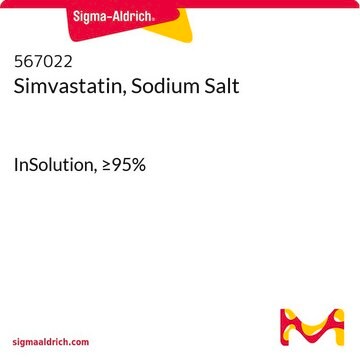M2537
Mevastatin
≥98% (HPLC), powder or crystals
Sinónimos:
Compactin, ML-236B
About This Item
Productos recomendados
Análisis
≥98% (HPLC)
formulario
powder or crystals
color
white to light yellow
mp
151 °C
solubilidad
ethanol: 25-26 mg/mL, clear, colorless
espectro de actividad antibiótica
neoplastics
Modo de acción
enzyme | inhibits
emisor
Daiichi-Sankyo
temp. de almacenamiento
2-8°C
cadena SMILES
[H][C@]12[C@H](CCC=C1C=C[C@H](C)[C@@H]2CC[C@@H]3C[C@@H](O)CC(=O)O3)OC(=O)[C@@H](C)CC
InChI
1S/C23H34O5/c1-4-14(2)23(26)28-20-7-5-6-16-9-8-15(3)19(22(16)20)11-10-18-12-17(24)13-21(25)27-18/h6,8-9,14-15,17-20,22,24H,4-5,7,10-13H2,1-3H3/t14-,15-,17+,18+,19-,20-,22-/m0/s1
Clave InChI
AJLFOPYRIVGYMJ-INTXDZFKSA-N
Información sobre el gen
human ... HMGCL(3155) , HMGCR(3156)
rat ... Hmgcr(25675)
¿Está buscando productos similares? Visita Guía de comparación de productos
Descripción general
Aplicación
- to analyze its effects on chronic lymphocytic leukemia (CLL) cells by cytotoxic assay
- as a prenylation inhibitor to analyze its effects on human embryonic kidney (HEK) cells transfected with K-Ras
- as a statin agent to study its anti-cancer effect on human breast cancer cells and glioblastoma in vitro
Acciones bioquímicas o fisiológicas
Características y beneficios
Envase
Código de clase de almacenamiento
11 - Combustible Solids
Clase de riesgo para el agua (WGK)
WGK 3
Punto de inflamabilidad (°F)
Not applicable
Punto de inflamabilidad (°C)
Not applicable
Equipo de protección personal
Eyeshields, Gloves, type N95 (US)
Certificados de análisis (COA)
Busque Certificados de análisis (COA) introduciendo el número de lote del producto. Los números de lote se encuentran en la etiqueta del producto después de las palabras «Lot» o «Batch»
¿Ya tiene este producto?
Encuentre la documentación para los productos que ha comprado recientemente en la Biblioteca de documentos.
Los clientes también vieron
Artículos
Cholesterol synthesis regulation by dietary levels, LDL receptors control lipid-rich LDL particle transport in cells.
Discover Bioactive Small Molecules for Lipid Signaling Research
Nuestro equipo de científicos tiene experiencia en todas las áreas de investigación: Ciencias de la vida, Ciencia de los materiales, Síntesis química, Cromatografía, Analítica y muchas otras.
Póngase en contacto con el Servicio técnico












